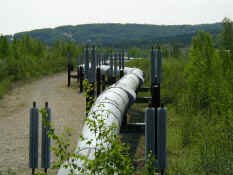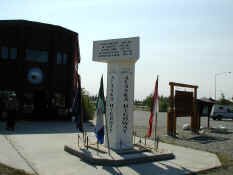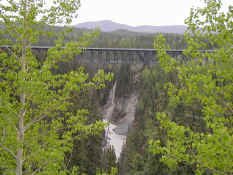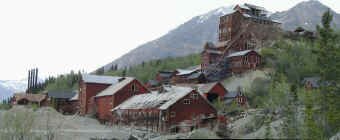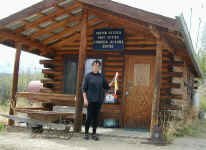May 26
May 27
May 28
May 29
May 30
Today we spent the day pipeline and bird watching along the Steese Highway. There is a big fire off the Chena Hot Springs Road and it is making Fairbanks very hazy. Going north gets us out of the smoky area for now and into blue skies.
Our first view of the Trans Alaska Pipeline System came just north of Fairbanks. The pipeline was built from 1975-1977 and at 800 miles long, is one of the longest pipelines in the world. It crosses three mountain ranges and more than 800 streams and rivers.
After our lesson in pipelines, we continued up the highway toward the Chatanika River. We stopped to view a couple of old dredges in this old mining area. The stream banks were completely dug up and searched through by the dredges for gold. Surprisingly the tailing piles left over from the dredging has sprouted trees. It is amazing how the earth heals itself. We also passed the pipeline a few more times.
Near the Chatanika River are numerous ponds that are stocked with fish by Alaska Fish and Game. This also helps bring in ducks and other birds. We spent the afternoon adding birds like the Oldsquaw, Horned Grebe, Lesser Scaup and White-winged Scoter to our list of sighted birds.
We passed several of the pipeline pumping stations and had numerous views of the line itself. We also passed from blue skies and warm days back to overcast skies and frozen lakes.
We also passed through Copper Center. This was a government agriculture experiment station and a telegraph service station. The town was full of old buildings, the best collection we've seen in one place.
It was here that we turned off the highway for our adventure down to McCarthy and the Kennecott mine.
The road to McCarthy is 60 miles long and full of rocks, washboard and ruts and considered by many to be the worst road in Alaska. Just the type of road we've been looking for to get off the beaten path. It follows the railroad bed of the old Copper River and Northwestern Railway (CRNW) that was built by the Kennecott Mine Corporation to move copper ore from the mine to Cordova on the coast to be loaded on ships. Therefore there are still railroad spikes and wooden railroad ties to be avoided. It also has a 525 ft. long bridge that is 238 ft. above the river. The locals called the railway (CRNW) the "can't run never will" because of the difficulty in its construction. The railway did run and over its life carried over $200,000,000 of copper!
| This bridge was originally built in 1910 and refurbished in 1988. It was at that time that the guardrails were added. As we were crossing this one lane engineering marvel, I kept imagining what it would have been like to drive across it with no guard rails. No thank you! |
Our drive to the end of the road was fortunately uneventful. The road ends at the Kennicott River (note the two different spellings of the word, I'll explain later) and visitors to McCarthy and the mine must walk across two footbridges constructed in 1997 after the river washed out the car bridges for the gazillionth time. The walk to McCarthy is only a 1/2 mi. but the walk to Kennecott is 5 miles, so we decided to take the shuttle.
The Kennecott mine was built by investors such as the Morgans and Guggenheims after geologists discovered the wealth of copper ore in the mountains alongside the Kennicott Glacier. The remoteness of the the area and the expense that would be incurred bringing the ore out made the mine an expensive proposition, but the quality of the ore (12% copper) and the amount of it made it worthwhile. The mine operated from 1911 till 1938 and brought out approximately $200 million worth of copper ore. The mine was named after the nearby Kennicott Glacier but the name was misspelled causing spelling debates to this day.
During its heyday, the mine employed 600 people. 300 additional people were needed to operate and maintain the railway. Kennecott became a self-contained company town complete with a hospital, general store, schoolhouse, baseball field, skating rink, tennis court, recreation hall and dairy. Legend has it that rules were strict regarding conduct in town so the town of McCarthy sprang up nearby to add the spice of restaurants, pool halls and other "entertainment"
The town became a ghost town shortly after the last train pulled out in 1938. A resurgence began in the 60's and 70's and the creation of the Wrangell-St. Elias National Park and Preserve in 1980 helped stimulate the growth in tourism that continues today. The site was purchased by the Park Service in 1998 and they are working to stabilize the structures. Because of the deterioration over the years we were not allowed to enter the buildings but we were able to wander around the outside of the buildings and view all of the historic artifacts that litter the ground. It was an absolutely fascinating afternoon.
Today we were retracing our footsteps as we said our final goodbyes to the Wrangell-St. Elias Nat'l Park & Preserve. We are on our way to the Top of the World. This is the name of the road that crosses over the mountains from central Alaska to central Yukon and on to Dawson City, the destination of the stampeders of the Yukon Gold Rush.
Our drive today took us back down the roads that we took nearly three weeks ago when we arrived in Alaska. We spent the night in the town of Tok, and tomorrow we head up to gold camps with names like Chicken and Eagle. We did have several good animal sightings: two golden eagles, two caribou and a bull moose who was crossing a pond. No grizzlies yet.
Today after driving up the Taylor Highway, we spent the afternoon with the Hammond Family. We were introduced to them by the correspondence school coordinator at Tok School. Dick mines and traps for a living, Robin is the postmaster in Chicken and their two girls, Darcy and Emmy attend school via satellite correspondence classes and have horses that they tend and show. It was very interesting to spend an afternoon with the girls and hear about their lives living in the "outback" of Alaska. The Hammonds maintain two homes since Robin is the postmaster and she has to go to work daily whether its sunny and warm or dark and cold. Dick mines and traps out of their home at 45 mile which is two hours away. Robin and the girls stay at the home closer to town with the horses. They all get together several times a week.
Their daily lives are filled with work, school and chores. The girls attend school via satellite from 10am to 5pm. Since they don't have a telephone their classes aren't interactive. If they have a question about something from the class, they ask their parents to explain it or they can research the question on the internet which they can also pick up via satellite. They have projects to complete and lessons to follow. Periodically when they are in Tok (66 mi. away) they take tests to gauge their progress and they regularly score above the 90th percentile. Since they live in a community of 35 people, Robin makes sure that the girls are socially active through camps and horse shows. Both girls are intelligent, friendly and independent.
Unfortunately, Dick wasn't at home when we visited, but he leads a busy, interesting life as well. During the summer months he mines for gold using time-tested methods and during the winter he traps and sells the furs.
We talked about how they deal with temperatures during the winter that can get as low as -70 degrees F. Basically you spend as little time outside as necessary. But when you do go out, special precautions are taken. Feet are especially vulnerable. Robin has a pair of boots made out of leather around the foot and a waterproof material up to the knees. She called them her "fifty-below boots". Layers of fleece, wool socks and down parkas are a necessity. The girls also had beautiful fur lined hats made from martens that Dick had trapped.
We also discussed the lack of sunlight during the winter. Robin explained that the dark isn't complete darkness. There is a twilight aspect to it and that the days are more like regular days than the summer days. During the summer, there is sunlight all the time and it never really gets dark at all, but during the winter, the daytime is just kind of like the sun behind a mountain and then regular darkness. She also was telling us that when the sun does reappear it is really beautiful because the angle of the sun when it comes over the horizon is at that "sunset" angle where the colors are just beautiful.
It was a very interesting and informative afternoon. We're happy to call the Hammonds new friends.
